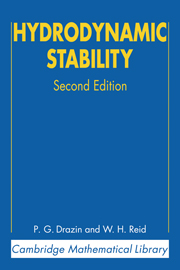Book contents
- Frontmatter
- Contents
- Foreword by John Miles
- Preface
- 1 INTRODUCTION
- 2 THERMAL INSTABILITY
- 3 CENTRIFUGAL INSTABILITY
- 4 PARALLEL SHEAR FLOWS
- 5 UNIFORM ASYMPTOTIC APPROXIMATIONS
- 6 ADDITIONAL TOPICS IN LINEAR STABILITY THEORY
- 7 NONLINEAR STABILITY
- APPENDIX: A CLASS OF GENERALIZED AIRY FUNCTIONS
- Addendum: Weakly non-parallel theories for the Blasius boundary layer
- Solutions
- Bibliography and author index
- Motion picture index
- Subject index
3 - CENTRIFUGAL INSTABILITY
Published online by Cambridge University Press: 06 August 2010
- Frontmatter
- Contents
- Foreword by John Miles
- Preface
- 1 INTRODUCTION
- 2 THERMAL INSTABILITY
- 3 CENTRIFUGAL INSTABILITY
- 4 PARALLEL SHEAR FLOWS
- 5 UNIFORM ASYMPTOTIC APPROXIMATIONS
- 6 ADDITIONAL TOPICS IN LINEAR STABILITY THEORY
- 7 NONLINEAR STABILITY
- APPENDIX: A CLASS OF GENERALIZED AIRY FUNCTIONS
- Addendum: Weakly non-parallel theories for the Blasius boundary layer
- Solutions
- Bibliography and author index
- Motion picture index
- Subject index
Summary
It seems doubtful whether we can expect to understand fully the instability of fluid flow without obtaining a mathematical representation of the motion of a fluid in some particular case in which instability can actually be observed, so that a detailed comparison can be made between the results of analysis and those of experiment.
– G.I. Taylor (1923)Introduction
Instability also occurs in a homogeneous fluid owing to the dynamical effects of rotation or of streamline curvature. Three important examples of flows which exhibit this type of centrifugal instability are shown in Fig. 3.1. They are Couette flow, in which the fluid is contained between two rotating coaxial cylinders; flow in a curved channel due to a pressure gradient acting around the channel; and the flow in a boundary layer on a concave wall. In the absence of curvature, the last two of these examples may exhibit the type of instability associated with parallel shear flows, which will be discussed in Chapter 4.
The instability of rotating flows was first considered by Rayleigh (1880, 1916b). He considered a basic swirling flow of an inviscid fluid which moves with angular velocity Ω(r), an arbitrary function of the distance r from the axis of rotation. By a simple physical argument Rayleigh then derived his celebrated criterion for stability.
- Type
- Chapter
- Information
- Hydrodynamic Stability , pp. 69 - 123Publisher: Cambridge University PressPrint publication year: 2004
- 1
- Cited by

